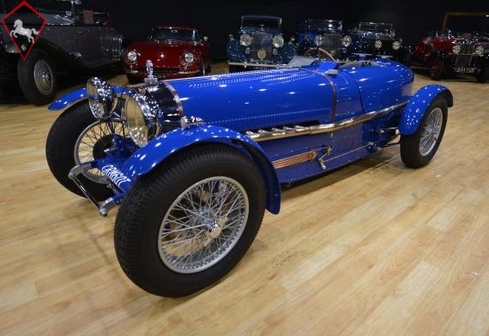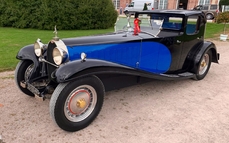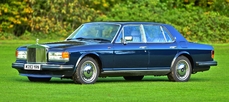Bugatti Type 59 Bugatti Type 59 Grand Prix Replica 1978
General description :
1933/1978 Bugatti Type 59 Grand Prix Replica
Registration Number: CRM60T
This Grand Prix Bugatti replica is based on a 4.2 litre Jaguar engine built to the highest standard and supercharged with a highly efficient helical blower. The blower is low pressure to ensure a smooth running engine with excellent low rpm torque characteristics but without the stress and issues associated with higher boost pressures.
Overall this car is engineered to the very highest standards with many hundreds of bespoke components and absolutely no compromise to quality, reliability and detail.
The gear change has been positioned on the right hand side through a similar style cross shaft to the original car. The central hand brake is cable operated per original. Many of the other controls are also closely based on the original.
Cooling is by a correct honeycomb core radiator and a prototypical oil cooler mounted on the chassis.
Road equipped with mudguards and lights based on a style of a similarly equipped type 54. So from this point of view the replica is a type 59 with strong type 54 influence.
This car is believed to be the best modern based Grand Prix Bugatti replica in existence and in sight, sound and feel, the nearest experience to a genuine pre war racing car.
Technical Information:
Cold Starting:- When starting from cold the engine and in particular the inlet manifold need to come up to operating temperature. There is a need to warm the engine at a steady and constant throttle opening to avoid pulling too much liquid fuel into the manifold before it is warm, this causes rough running and is not kind to both supercharger and engine. ‘Blipping’ the throttle is to be avoided until the engine temperature gauge has risen off the stop pin.
Ensure the car is in neutral with the hand brake applied.
Push the choke lever down. Long lever beside the instrument binnacle.
Switch on the Battery Isolater switch located under the drivers seat.
Turn the main switch under the instrument binnacle to the first position.
Place a foot on the throttle and cause the throttle to be open approximately 1/8 of full travel.
Press the starter button under the instrument binnacle until the engine starts.
Immediately on starting regulate the throttle to give an engine speed of 1,000 to 1,200 rpm. Maintain this speed until the temperature gauge needle lifts off the stop pin.
After a short period of around 30 seconds after starting the engine note will change slightly to indicate a rich mixture and the choke can be fully closed.
Once the temperature has started to rise the throttle pedal can be released gently to allow the engine to settle into idle speed.
Now that the engine is sufficiently warm the car can be driven in the normal way.
Warm Starting:- There is now no need to warm the engine at a steady and constant throttle opening as long as there is sufficient heat in the engine and manifold.
Ensure the car is in neutral with the hand brake applied.
The choke lever is not required for a warm start.
Switch on the Battery isolator switch located under the drivers seat.
Turn the main switch under the instrument binnacle to the first position.
Place a foot on the throttle and cause the throttle to be open approximately 1/8 of full travel.
Press the starter button under the instrument binnacle until the engine starts.
Immediately on starting release the throttle gently to allow the engine to settle into idle speed.
The car can be driven in the normal way.
Supercharger:- The car utilises a Sprintex S102 supercharger. This unit requires 50wt hypoid type gear oil. The oil tank for the supercharger is located low on the bulkhead on the passenger side of the car. This is filled from the cap on the top of the bulkhead and the oil level should be at least half way up the sight glass on the tank side and no higher than the top of the sight glass. Take care to ensure the oil lines to the supercharger front gear casing do not get kinked. Oil can be pulled artificially into the gear case by drawing a vacuum for a short time on the supercharger breather pipe, this is the small pipe located inside the oil tank filler.
The rear bearings of the supercharger are lubricated by grease as recommended by Sprintex. This is done at higher mileage intervals according to the Sprintex maintenance guidelines. Rear bearing lubrication does require removal of the supercharger. However at these mileages it would be wise to remove the blower for a visual inspection of the rotors.
The supercharger is removed by firstly removing the bolts retaining the input shaft extension then by releasing the four bolts holding the supercharger to the rear mounting / manifold base. Do not remove this steel bracket as it forms the rear water space cover of the cylinder block. The exhaust manifold must be removed to gain access to the supercharger.
The supercharger drive shaft from the engine runs on sealed for life bearings. These are in pairs and lightly preloaded on assembly and do not require routine maintenance or lubrication. Drive is by two toothed belts and normal tooth belt tension should be applied to these, again maintenance is not normally required.
The inlet manifold is heated by engine cooling water and forms the thermostat bypass. This take off is what would normally provide hot water to a car for its passenger compartment heating. This heating is required to prevent carburettor icing and to reduce fuel condensation in the inlet manifold.
Radiator and Cooling System:- The main radiator is a traditional hexagonal vintage core mounted in an external shell. If required the radiator can be removed from this shell. The full radiator assembly is first removed from the car (The top suspension wish bones and coil spring dampers should be undone and pulled back to allow the radiator to lift upwards). The core is then removed by unscrewing the filler pipe and removing the bottom studs. An additional return bend cooler is fitted underneath the car on the passenger’s side, this provides additional cooling and water volume. A fixed fan is fitted to the engine, there is a temperature gauge in the cockpit, plus a functioning calorimeter on the radiator cap. When filling the radiator use water plus a ‘Non-OATS’ antifreeze, fill to just above the visible radiator matrix and no further. The radiator is non-pressurised with an overflow pipe, an overfilled radiator will cause water to be ejected from this pipe. There is an anti-surge pot fitted inside the radiator filler neck, this must be in place to prevent turbulence in the top tank causing an excess of water to be ejected from the overflow. The surge pot is lifted out to allow the water level to be checked and topped up.
Oil Cooling system:- Two oil coolers are fitted in the oil circuit of the car with a take-off located behind the engines cartridge oil filter. The replica Bugatti oil cooler is located on the left hand side of the chassis and a conventional oil cooler is located centrally and horizontally on the chassis bottom rails between the front wheels. Air is ducted from above and exhausted below.
Suspension:- A conventional coil spring and damper arrangement is utilised. The dampers are adjustable for spring tension and damping. The spring tension adjusting rings will not need to be altered, however the small knurled knobs at the bottom of each damper can be altered to adjust the cars handling. At the rear a set of imitation leaf springs are fitted to replicate the appearance of the prototype car. These are resilient mounted to the axle and are free to rotate on pre-loaded ball races at their root. They are not load bearing on the rear axle.
Braking system and Clutch:- The braking system is servo assisted hydraulic brakes. The break servo is located on the bulkhead behind the driver’s seat and is accessible from underneath the car. The break hydraulic reservoirs are located in front of the driver’s foot well under the bonnet. The clutch cylinder is also located here. The foot brake has two cylinders linked by a brake balance bar located in the foot brake pedal. Brake front to rear balance can be adjusted by this balance bar should the need arise. The hand brake is cable operated from the centrally mounted lever on a ratchet. The hand brake cable is not a pre-stretched cable and as such the hand brake will run full travel on the ratchet in operation. A pre-stretched cable could be fitted should this be required. The prototype car was fully cable braked and imitation cables are fitted to the car to ensure that the correct look is achieved. These cables are non-functional and are lightly tensioned with a spring device on the rear axle to compensate for any suspension movement.
Exhaust system:- The exhaust system has a removable muffler insert which pushes into the end of the tail pipe. This muffler is required for any vehicle test inspections and reduces the exhaust noise sufficiently.
Overdrive:- An overdrive unit is fitted and operated by a toggle switch on the right hand side of the bulkhead. The overdrive is NOT wired into the lockout switch on the gearbox. This lockout could be incorporated if required and would be wired in series with the overdrive solenoid. The overdrive should only be used in 3rd and top gears only.
Battery and Electrical:- The Battery is located under the passenger seat and is accessible by removing the seat squab, two twist tabs under the front edge of the seat. A cover plate is then removed by means of a set of posidrive screws. The battery can be charged through a banana plug located under the passenger seat without the need to remove the seat squab or battery cover. A battery isolator switch is fitted under the driver’s seat. There are two rotary switches located under the instrument binnacle, the first one controls the ignition and lights. Position 1, ignition. Position 2 Side Lights. Position 3 Headlights. A separate dip switch is fitted to the bulkhead next to the overdrive switch. A second forward facing rotary switch located under the instrument binnacle controls the indicators, the indicators are not self-cancelling. The final switch under the instrument binnacle is the push button to activate the starter motor. On the right hand side of the instrument binnacle is a push button to operate the horn. The location of the electrical switches is intended to give a clean visual look to the cockpit more in keeping with the prototype vehicle.
The ignition coil is fitted on a vertical plate between the front and rear engine bay bulkhead. The fuse board is also located in this area. A Luminition electronic ignition system is fitted. In addition a supercharger ignition retard is fitted, due to the low pressures developed in the supercharger this is not really needed but is fitted as a matter of course.
A mechanical speedometer is fitted. This is a new unit and replaces an electronic unit fitted when the car was built. The electronic unit failed at around 2,500 miles. The failed electronic unit is included for mileage verification of the point of change over.
Not for the faint of heart or shy retiring types; the car may be viewed by prior appointment at our showrooms.
http://www.vintagerollsroycecars.com/car-details/19331978-bugatti-type-59-grand-prix-replica_1047.html
1978 Bugatti Type 59 Bugatti Type 59 Grand Prix Replica is listed sold on ClassicDigest in Grays by Vintage Prestige for £78000.
Car Facts
Car type : Car Make : Bugatti Model : Type 59 Model Version : Bugatti Type 59 Grand Prix Replica Engine size : 0.0 Model Year : 1978 Sub type : Pick up Location : Essex Vehicle Registration : Normal
Sold
Seller Information
Sold
People who viewed this Bugatti Type 59 also viewed similar Bugatti listed at ClassicDigest
Other cars listed for sale by this dealer
About Bugatti
Ettore Bugatti, born in Milan, Italy, founded the automobile company bearing his name in 1909 in Molsheim then part of the German Empire until 1919.Bugatti was known both for the level of detail of its engineering and for the their art nouveau design.
Over the years, they produced a series of luxury cars, such as Bugatti Royale, as well as some of the most famous racing cars. Bugatti Type 35 is likely to be the most successful racing car of all time, with more than 2.000 wining positions.
The death of Ettore Bugatti's son, Jean Bugatti, while testing a Type 57 tank-bodied race car, marked a turning point in the company's fortunes. Ettore Bugatti died on 21 August 1947. Following Ettore Bugatti's death in 1947, the business declined further and Bugatti finally ceased operations in 1952.







